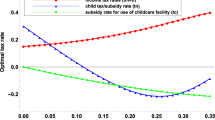Abstract
Analyzing a homogenous household setting with endogenous fertility and endogenous labor supply, we demonstrate that moving from joint taxation to individual taxation and adapting child benefits so as to keep fertility constant entails a Pareto improvement. The change is associated with an increase in labor supply and consumption and a reduction of the marginal income tax, while the child benefit may move in either direction. Similarly, a move from joint taxation to some scheme of family tax splitting increases labor supply and welfare.
Similar content being viewed by others
References
Apps P, Rees R (1999) Individual versus joint taxation in models with household production. J Polit Econ 107(2):393–403
Apps P, Rees R (2004) Fertility, taxation and family policy. Scand J Econ 106(4):745–763
Apps P, Rees R (2011) Optimal taxation and tax reform for two-earner households. CESifo Econ Stud 57(2):283–304
Balestrino A (2001) On the optimal fiscal treatment of family size. Finanzarchiv 58(2):140–157
Balestrino A, Cigno A, Pettini A (2002) Endogenous fertility and the design of family taxation. Int Tax Public Financ 9(2):175–193
Beblo M, Beninger D, Laisney F (2004) Family tax splitting: a microsimulation of its potential labour supply and intra-household welfare effects in Germany. Appl Econ Q 50(3):233–250
Boskin M, Sheshinski E (1983) Optimal tax treatment of the family: married couples. J Public Econ 20(3):281–297
Brett C (2007) Optimal nonlinear taxes for families. Int Tax Public Financ 14(3):225–261
Cigno A (1983) On optimal family allowances. Oxf Econ Pap 35(1):13–22
Cigno A (1986) Fertility and the tax-benefit system: a reconsideration of the theory of family taxation. Econ J 96(384):1035–1051
Cigno A (2009) What’s the use of marriage? IZA discussion paper no. 4635, Bonn
Cigno A, Pettini A (2002) Taxing family size and subsidizing child-specific commodities? J Public Econ 84(1):75–90
Cigno A, Luporini A, Pettini A (2003) Transfers to families with children as a principal-agent problem. J Public Econ 87(5–6):1165–1177
Cremer H, Dellis A, Pestieau P (2003) Family size and optimal income taxation. J Popul Econ 16(1):37–54
Evers M, De Mooij R, Van Vuuren D (2008) The wage elasticity of labour supply: a synthesis of empirical estimates. De Economist 156(1):25–43
Feldstein M, Feenberg DR (1996) The taxation of two-earner families. In: Feldstein M, Poterba JM (eds) Empirical foundations of household taxation. University of Chicago Press, Chicago, pp 39–76
Fraser CD (2001) Income risk, the tax-benefit system and the demand for children. Economica 68(269):105–125
Immervoll H, Kleven HJ, Kreiner CT, Verdelin N (2011) Optimal tax and transfer programs for couples with extensive labor supply responses. J Public Econ 95(11–12):1485–1500
Kleven HJ, Kreiner CT (2007) Optimal taxation of married couples with household production. Finanzarchiv 63(4):498–518
Kleven HJ, Kreiner CT, Saez E (2009) The optimal income taxation of couples. Econometrica 77(2):537–560
Meier V, Rainer H (2010) On the optimality of joint taxation for non-cooperative couples. CESifo working paper no. 3128, Munich
Pencavel J (1986) Labor supply of men: a survey. In: Ashenfelter O, Layard R (eds) Handbook of labor economics, vol 1. Elsevier, Amsterdam, pp 3–102
Piggott J, Whalley J (1996) The tax unit and household production. J Polit Econ 104(2):398–418
Steiner V, Wrohlich K (2008) Introducing family tax splitting in Germany: how would it affect the income distribution, work incentives, and household welfare? Finanzarchiv 64(1):115–142
Acknowledgments
We would like to thank two anonymous referees and participants at conferences and seminars at Bamberg, Barcelona, Copenhagen, Essen, Galway, Munich, Tallinn, and Vienna for many valuable and useful comments and suggestions.
Author information
Authors and Affiliations
Corresponding author
Additional information
Responsible editor: Alessandro Cigno
Electronic Supplementary Material
Below is the link to the electronic supplementary material.
Rights and permissions
About this article
Cite this article
Meier, V., Wrede, M. Reducing the excess burden of subsidizing the stork: joint taxation, individual taxation, and family tax splitting. J Popul Econ 26, 1195–1207 (2013). https://doi.org/10.1007/s00148-011-0400-x
Received:
Accepted:
Published:
Issue Date:
DOI: https://doi.org/10.1007/s00148-011-0400-x




